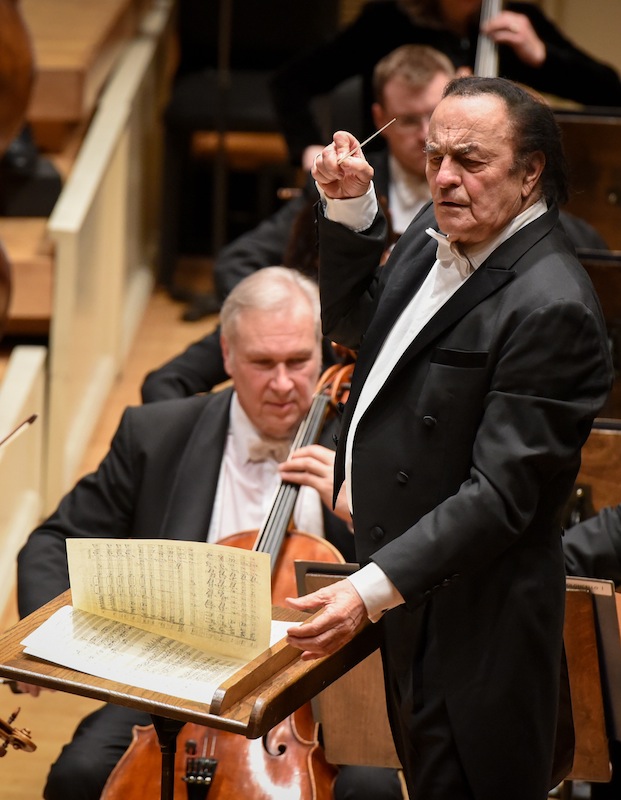Dutoit, CSO make musical history with a belated Stravinsky premiere

On January 30, 1909, a memorial concert took place in the Great Hall of the St. Petersburg Conservatory honoring Nikolai Rimsky-Korsakov. At that concert a new orchestral work was premiered, Chant funebre, written by the 26-year-old Igor Stravinsky, a Rimsky student, for the occasion.
In the ensuing chaos of the Russian Revolution, the manuscript of the work (Pogrebal’naya Pesyna), and all the orchestra parts were lost for over a century until discovered by Stravinsky scholar Natalia Braginskaya in 2015. Valery Gergiev led the Mariinsky Orchestra in only the second performance of the work, which took place last December in the same hall in which it was premiered 117 years earlier.
The Chicago Symphony Orchestra managed a remarkable coup, nabbing the rights to Chant funebre for the U.S. premiere of this long-lost work, which took place Thursday night under the baton of Charles Dutoit.
Stravinsky himself lamented the work’s disappearance in his memoirs. Though he was confused about the orchestration–recalling the symphonic work as scored for winds alone—he wrote, “I remember the piece as the best of my works before The Firebird, and the most advanced in chromatic harmony.”
And that sums it up most accurately. The 12-minute Chant funebre is a crucial work in Stravinsky’s musical development, coming between Fireworks and The Firebird, the ballet that made his name.
It is impossible to overstate the musical importance of this historic discovery. Yet perhaps most gratifying–as was made clear last night–is that Chant funebre (or Funeral Song) is a strong and impressive work in its own right, the young Stravinsky taking a big leap forward in his writing for orchestra.
Though written as a homage to his beloved teacher, Chant funebre is a clear way-station between Fireworks and the composer’s first successful ballet. Indeed, the music starts with a pre-echo of the opening bars of Firebird with hushed rustling of the double-basses, which leads into a slow-moving processional. The elegiac note is sounded in a theme for solo horn, echoed in strings and muted trumpet. A dirge-like motif dominates the music with alternating passages, as in a wavy theme for three flutes, and the trumpet and brass trading phrases with strings. The music rises to a sudden shimmering climax, punctuated by timpani, cymbals and bass drum, followed by a lugubrious bassoon solo before ending in a quiet coda. One can see this dignified, evocative music quickly entering the repertory, especially for concerts marking a significant passing.
It was fitting that it fell to Charles Dutoit to be in charge of this important premiere. The Swiss conductor is one of our finest Stravinsky hands, as was manifest in his memorable CSO performances of the complete Firebird last season. Dutoit led a tensile and concentrated performance that brought out all of the scoring details clearly while conveying the valedictory atmosphere, with luminous and expressive playing by the orchestra.
From an early long-lost work of Stravinsky to a late masterwork by his compatriot Serge Prokofiev to close the evening. This week’s performance of the Symphony No. 5 would appear to mark another installment in the CSO’s season-long Prokofiev series, though, oddly, there was no mention of the 125th birthday project in the program.
The opening Andante felt rather unfocused and lumbering Thursday night, but gradually got on track, Dutoit building the brooding atmosphere organically to a punchy climax. The motoric drive of the second movement went with a jaunty, insouciant air at Dutoit’s fleet tempo.
Characteristically, Dutoit didn’t overplay the darker emotions of the Adagio, his flowing tempo keeping this reflective music focused yet skirting the lachrymose. Likewise the finale was aptly exuberant–with delightful clarinet work by Stephen Williamson–yet held on a tight rein. The conductor concentrated on balance and transparency, even as the percussion-driven machine spins out of control at the coda.
The evening’s centerpiece was Antonin Dvořák’s not unfamiliar Cello Concerto in B minor. With CSO creative consultant Yo-Yo Ma making annual appearances with the orchestra, local audiences have fewer opportunities to hear other international cellists than is the case with pianists or violinists.
So it was a pleasure having Truls Mørk return after a 12-year absence to bring his artistry and insight to this Dvořák evergreen. The Norwegian cellist’s technique remains unassailable and he brought burnished tone and sturdy strength to the dramatic passages with firmly projected playing throughout.
Yet most striking were the interior passages where much of this concerto lives. In the Adagio, Mørk’s introspective rumination distilled the nostalgic ache at the heart of this score. Likewise his hushed rendering of the finale’s solo passage before the fiery coda was uncommonly fresh and touching.
Dutoit’s brisk, unsentimental style didn’t always align with the Czech composer’s lyric warmth. But for the most part, he was a responsive and alert collaborator for his soloist, drawing worthy support from the orchestra, with notably bucolic clarinet solos from John Bruce Yeh.
The program will be repeated 1:30 p.m. Friday, 8 p.m. Saturday and 7:30 p.m. Tuesday. cso.org; 312-294-3000.
Posted in Performances





